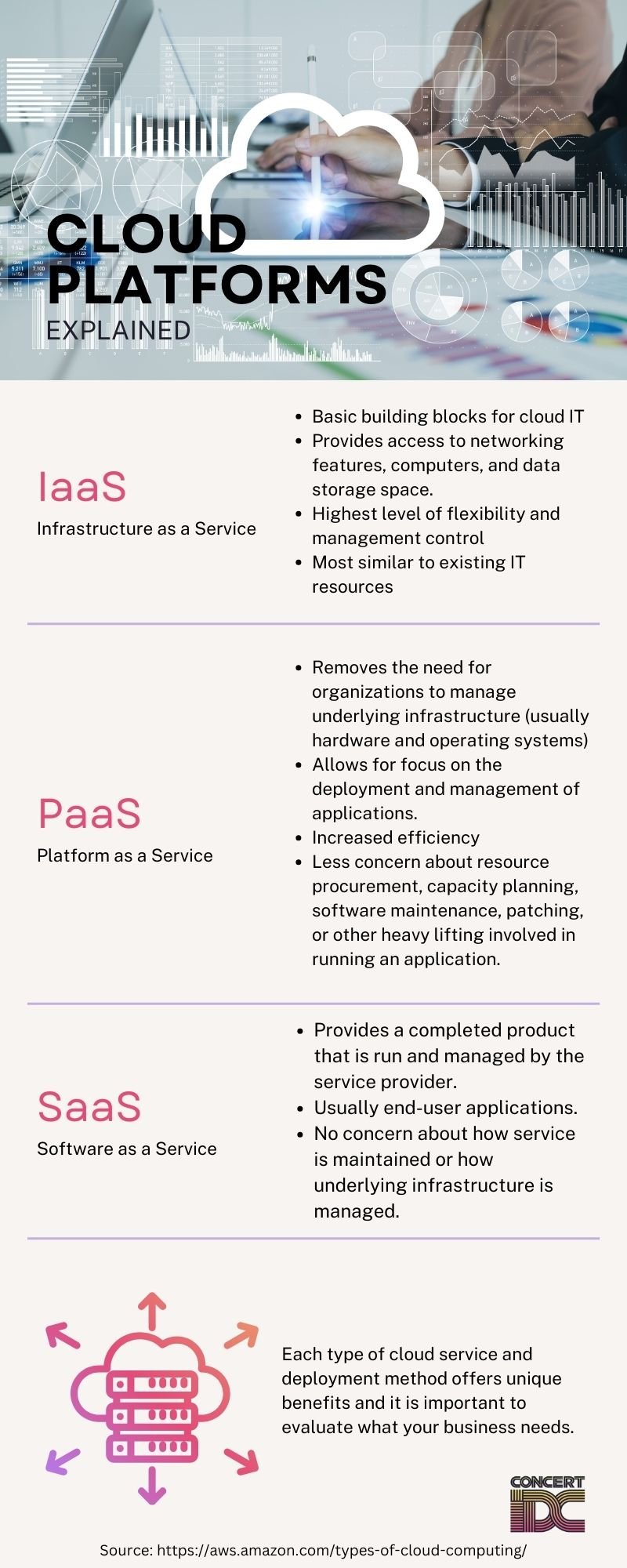Choosing the Right Cloud Solution: SaaS, PaaS, and IaaS Explained
Read Time 9 mins | Written by: Sarah Grace Hays

In today’s tech landscape, there are a few things you must be knowledgeable about. One of these things is cloud computing. While it isn’t the newest concept, it is perpetually relevant, and many people have yet to switch to a cloud system.
The first version of cloud computing emerged in the 1960s when systems like these were far more novel and expensive. There were extreme limitations on this version of “clouds” because there were a lot of tech avenues unexplored.
In 1999, Salesforce offered the first applications over the internet. This marked the arrival of SaaS or Software as a Service.
SaaS is a complete application stack as a cloud service. This includes all maintenance and management from underlying infrastructure to application software. A SaaS cloud service offers many benefits.
First, because of the reduced time spent on installation and configuration, you need less time to deal with the issues that arise in software deployment. SaaS is also incredibly cost-effective because it resides in a shared environment. There are also reduced maintenance costs because the SaaS provider owns the environment, and the cost is split between all customers utilizing that solution.
Like other cloud services, SaaS is easily scalable. This is partly due to the ability to integrate with other SaaS offerings. The service provider employs upgrades to the system, which are easily deployed and accessible to the user.
In 2006, Amazon launched the first commercial cloud, Google followed suit in 2008, and in 2010, Microsoft came out with Azure.
Amazon’s AWS and Microsoft’s Azure are two of the most popularly used platforms in cloud computing, offering Software as a Service, Platform as a Service, and Infrastructure as a Service.
Both IaaS and PaaS services were popularized in the early 2010s.
PaaS or Platform as a Service products enable businesses to create and deploy consumer-facing apps on the cloud. Users can focus on building their apps without worrying about software upgrades, operating systems, storage, or other infrastructure elements.
PaaS offers a high level of control, scalability, incredible ease, and a great resource to keep developers happy.
Infrastructure as a Service, or IaaS, is the most similar cloud service to hardware. IaaS provides a place for businesses to manage their resources via the cloud. This model is a pay-as-you-use structure and removes the need for an expensive physical infrastructure.
IaaS is an excellent resource for large enterprise teams because of its easy access. It is also a flexible resource because you can adapt it for your business needs, only paying for what you use and saving money.

While each cloud computing solution is uniquely tailored to what your business needs, they all have some of the same benefits:
- A faster time to market
- Scalability and Flexibility
- Cost savings
- Better collaboration
- Advanced Security
- Data Loss Prevention
Cloud computing was popularized for a reason, and given the many good options available, there are a few ways to determine what cloud service might benefit your business goals.
A SaaS platform is best used for big collaborative projects, fast and lean launches, and mobile and web access. A few examples of SaaS platforms are Dropbox, Google Workspace, and Salesforce.
SaaS might be a good fit for startups lacking in-house resources, highly collaborative businesses, and businesses that must have web and mobile access.
A PaaS platform works well for teams building an app or when outside developers are needed. It especially works well with teams using an agile development methodology. A few examples of PaaS platforms are SAP Cloud and Heroku.
PaaS suits web developers, startups building apps, and enterprise organizations building in-house apps.
Finally, an IaaS platform provides complete control over an application when you are growing your business and need easy scalability based on resources. Some examples of IaaS are Rackspace and Joyent.
IaaS can benefit any company, given its pay-to-use structure, so it is adaptable.
Cloud computing isn’t new, meaning it is relatively easy to understand. If you think your business could benefit from cloud computing, please get in touch with us at info@concertidc.com to get started. We are experts on cloud services and can help your business make the necessary transformation.
Want to Learn How ConcertIDC Can Help Your Business?
Sarah Grace Hays
Marketing Director
